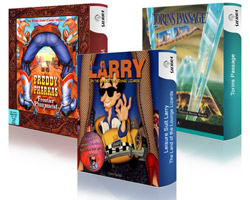OR: How We (re)Invented the Internet
After Larry 3 shipped, I thought the series had ended. Seeking another project, I spoke with Ken Williams about several game ideas. Maybe a humorous western game? (No, that came later; we called it Freddy Pharkas, Frontier Pharmacist.)
Ken offered instead something he had wanted to do for years: on-line gaming.
Back in the Dark Ages of the Commodore 64, Ken had published a helicopter flight simulator that included modem play. (I recall those Commodore modems were 300 baud, but I could be wrong. They might have been fast—1200!)
None of us knew anything about the Internet. Sure, we had all been on CompuServe and the other, lesser information services that were around back then. I’m sure I had read about something called ARPAnet, but we knew nothing about that. Remember, this was before there was a Cisco Systems. Ken thought there should be a way to play adventure games via modem.
So he assigned Jeff Stephenson (who was the head of Sierra’s AGI and SCI system programmers and responsible for much of the code of both of those languages) to work on a new programming language suitable for “modem gaming.” Jeff called it LSCI, for Large-model Script Code Interpreter. Later, when Sierra went public, someone in marketing made up the much more saleable phrase, “Sierra’s Creative Interpreter.” Jeff originally called it SCI simply because it ran scripts.
Ken also hired Matthew George as the “low level comm” guy to handle all the communications protocols. The three of us got a good-sized office and began filling it with wires and modems.
My job? Simple.
All I was had to do was to design the first interactive, multi-player, on-line adventure game.
Needless to say, I failed.
Hell, here it is a decade later, and still no one has done one. I now believe it’s impossible.
But, what did I know? I was young, foolish and confident—well, okay, definitely foolish. All I had to do was change adventures from single-person, sit-and-think, object-puzzles, inventory-manipulation, reading games to a game not requiring, or allowing, any of this. It had to be played by several players, where objects could be in any player’s possession, with no plot since everyone would be at a different place in the world…well, you can see that created conflicts that are impossible to resolve. But I wasn’t smart enough to realize that then.
Meanwhile, Jeff was reinventing the entire SCI code base, making many improvements while trying to make his code communicate with copies of itself running on an unknown number of machines of unknown speed delayed by unknown microseconds.
Matt was trying to decide just how many 2400-baud modems he could deal with. He found an expansion chassis for the old AT machines. We got several of those, plugged them into one main computer using every ISA slot available, then filled each slot in each expansion chassis with a modem. I think he got up to 32 modems in 4 chassis linked by ribbon cable to one poor old, brand new, high speed 386 with a whopping 8 megabytes of RAM. The local small-town telephone company loved us. We got 32 new phone lines into our office that week, each with Central Office rollover.
As I sweated out my design issues, I realized this system wouldn’t be viable for months. Maybe I could make some board games to test the new language’s communication ability? When they actually ran, and we could play checkers through dialup modems, we thought we were hot stuff! So I added chess. Still no system. So I added backgammon. I was running out of board games.
Ken insisted that the system be “easy enough so my grandmother can play bridge on it.” That necessitated quite a bit of work creating a front end, changing from one game to another, handling “waiting rooms” for people to gather, what happens when the 33rd player logs in and finds himself on another server with zero people, even though his buddy just phoned him and was on, etc. etc. And what did you look like? I made a “Mr. Potato Head” interface when you could decorate your own characters. Of course, all the graphics would be on disk. Your character would tell the other players how you looked by a string of digits: 2, 5, 1, 5, 3, etc. This meant you had face #2, with hair #5, eyes #1, etc. 1200 baud modems, remember?
But how could all this make money? Ken thought we would need 50,000 subscribers just to break even. Jeff, Matt, and I computed that it would take 40 fulltime employees just to stuff modems into expansion chassis and connect them to phone lines to handle those 50,000. And what about long distance? There were no 5-cent per minutes telephone calls back then. Even the cheapest long distance service was pricey. Maybe we should scatter servers throughout the United States? Where? How?
After six months, I realized my folly and begged off the project. Since I was not a salaried employee, but only got paid a percentage of sales, it was going to be years before I would see income. The sales department was clamoring for Larry 4. I decided to give it to them. (Of course, it ended up being named Larry 5, but that’s another story, kiddies.)
And what would we call this thing? Ken thought it would be perfect for lonely people who wanted to play a game with another human instead of a computer. My wife, Margaret, thought up the original name: “Constant Companion.” We liked it, but it didn’t stick. “The Sierra Network” was its name for years.
Years later, when TSN had its own building filled with hundreds of employees, they tried to create a “Larryland.” It was never an adventure game, but was a pretty fun environment with gambling and chat.
About then, when TSN was losing millions of dollars for Sierra each year, Ken sold half-interest in it to AT&T for $50 million. They renamed it “The ImagiNation Network” and immediately took out “Larryland” because it was “too risqué.”
A year later, AT&T bought the other half for another $50 million. We joked that Sierra was the only company that ever made a profit from on-line gaming! At that time, it was true. Ironically, AT&T started many big improvements, but in a year or so ended up selling INN to AOL for much less. Then AOL sat on it until it died.
But that’s another story, kiddies.




